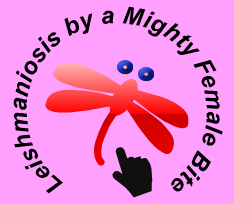Leishmaniosis
What is leishmaniasis?
Leishmaniosis (Leishmaniasis, leishmania disease, داء اللشمانيا) is a tropical and subtropical infectious disease caused by a protozoan parasite of the genus Leishmania and transmitted by the bite of a female phlebotomine sand fly.
Pathogen
What is the cause of leishmaniasis?
Leishmaniosis is an infectious disease caused by a protozoan parasite of the genus Leishmania.
Transmission
What is the vector of transmission for leishmaniasis?
Vector-borne transmission, transmitted to people by phlebotomine sand flies (blood-sucking arthropods), or by direct vertical (acquisition of Asaia symbionts or sand fly symbionts from mothers) and horizontal (among individuals of the same generation) transmission within the foxhound breed, which is then transmitted between species from animals to humans.[1][3][4]
Types
What are the types of leishmaniasis?
Two forms of leishmaniasis exist [2]
- Anthroponotic, commonly found in densely-populated urban settings mainly in central Asia and Syria where the disease is endemic.
- Zoonotic, is common in rural settings across central Asia, north Africa and south east Europe.
Most Leishmania species cause cutaneous leishmaniasis; however, most of these species are zoonotic, especially Leishmania infantum, which is the most common cause of canine leishmaniasis worldwide.
The life cycle of Leishmania involves a vertebrate (animals or humans) and an insect (a phlebotomine sand fly genus Lutzomyia). In endemic regions phlebotomine sand flies are the vectors for transmission.
Zoonotic visceral leishmaniasis (ZVL) is a disease of humans and domestic dogs, which is caused by Leishmania infantum and transmitted by phlebotomine sandflies.
Infections in humans are caused by more than 30 species of Leishmania, which can be identified by DNA sequence analysis, isoenzyme analysis or monoclonal antibodies; however, incidence of leishmaniasis in humans is relatively low, it is mainly transmitted from animals to humans through the bite of female sand flies, but humans can also transmit the parasite between each other through a blood transfusion of from a contaminated needle.[17]
Forms
How many types of leishmaniasis are there?
Four types of leishmaniosis are common [18]
What is cutaneous leishmaniasis?
Cutaneous leishmaniosis is the most common form of leishmaniosis, it is characterized by an ulceric sore at the sting site (the place of bite), which may heal in a period of few months leaving an ugly scar. Cutaneous leishmaniosis is a progressive form that may progress to any of the other three forms at any period.
What is visceral leishmaniasis?
Visceral leishmaniosis (VL, kala-azar, black fever, or Dumdum fever) is the most severe form of leishmaniosis, which is a systemic protozoan disease characterized by irregular bouts of fever, anorexia, hepatosplenomegaly, and severe anemia. If not treated, the fatality rate can be as high as 100% within 2 years. This disease is common in urban populations in Northeast Africa and the Indian subcontinent where the disease is endemic.[1][6][7]
What is mucocutaneous leishmaniasis?
Mucocutaneous leishmaniosis is an infectious disease caused by a unicellular parasite of the genus Leishmania and transmitted by sand fly bites, it presents with skin ulcers that mainly affects the philtrum (the nose and mouth area), which usually spread causing tissue damage.[1]
What is diffuse cutaneous leishmaniasis?
Diffuse cutaneous leishmaniosis (DCL) is a rare disseminated form of leishmaniosis characterized by widespread slowly progressive skin lesions, which may resemble leprosy, and is particularly difficult to treat, especially in immunosuppressed persons.
Pathogenesis
Leishmaniosis is transmitted by sand fly bites.
Female phlebotomine injects metacyclic promastigotes at the puncture wound. Then, the macrophages attack these Metacyclic promastigotes and digest them to form amastigotes.[1][12]
Amastigotes multiply and spread locally, the depth of penetration depend on the area involved and the immunity of infected individuals. Moreover, the severity of clinical manifestations depend on the depth and volume of penetration, which vary depending on the causative agent.[13]
Sandflies become infected by sucking blood containing macrophages infected with amastigotes from an infected host. In the sandfly’s midgut the amastigotes (parasites) differentiate into promastigotes, which then multiply into metacyclic promastigotes and migrate to the proboscis, where they are injected in new hosts.
Symptoms
What are the symptoms of leishmaniasis?
Leishmaniosis is a chronic infectious disease with a long incubation period, initial symptoms may show in a period ranging from 3 weeks to 7 years after infection occurs; however, for most people skin sores show 1-3 months after infection.[13]
Other clinical symptoms include
Cancerogenic symptoms, which include fever, lethargy, anemia, hepatosplenomegaly (enlarged spleen and liver).
In clinical medicine, leishmaniosis is considered a leading cause of massive splenomegaly (spleen >1000 g and >20 cm). The enlarged spleen is palpable about 8 cm below the costal margin.[14][15][16]
Diagnosis
How to diagnose leishmaniasis?
- Aspiration and biopsy of the bone marrow is used to diagnose, confirm, and/or stage visceral leishmaniasis
- The direct microscopic visualization of unicellular amastigotes (Leishman-Donovan bodies or LD bodies
) in monocytes and neutrophils.[8] - Enzyme-linked immunosorbent assay (ELISA)
- Direct agglutination test (DAT)
- Polymerase Chain Reaction (PCR), detection of Leishmania kDNA from the urine of patients with leishmaniasis.[9]
Treatment
What is the treatment for leishmaniasis?
Cutaneous leishmaniasis is often self healing; however, there are two common pentavalent antimonial drugs for the treatment of VL and cutaneous leishmaniasis
- Meglumine antimoniate (Glucantime), is a drug commonly used for treating leishmaniasis.[19][20][22]
- Sodium stibogluconate (Pentostam), is an injectable drug used to treat leishmaniasis.[23][25][26]
These drugs work by ultimately interrupting the trypanothione metabolism (energy production).
Amphotericin (AmBisome) is the drug of choice for treating patients with visceral or mucocutaneous leishmaniosis, especially those with proven antimony resistance.[29][30][31]
Miltefosine (Impavido), is a broad-spectrum phospholipid antimicrobial drug used for the treatment of cutaneous and visceral leishmaniosis. At a dose of approximately 2.5 mg/kg/day for 4 weeks, it cures 98% of patients, and is reasonably safe.[10][11][27]
>>>Natural remedy for Leishmaniasis (in Arabic)<<<
References
Verified by: Dr.Diab (November 9, 2017)
Citation: Dr.Diab. (November 9, 2017). Leishmaniosis Types Pathogenesis Clinic and Treatment. Medcoi Journal of Medicine, 21(2). urn:medcoi:article2675.















There are no comments yet
Or use one of these social networks